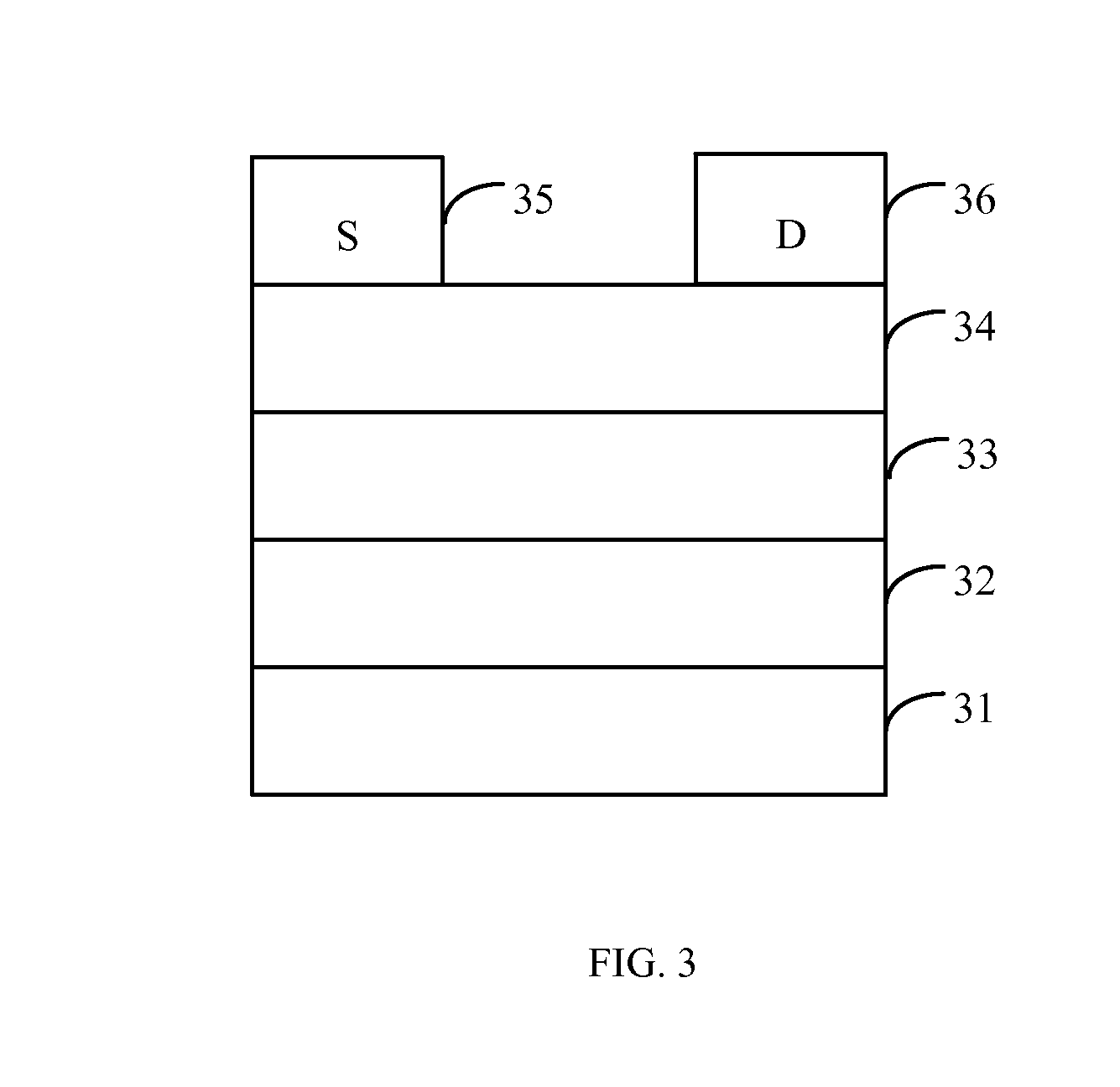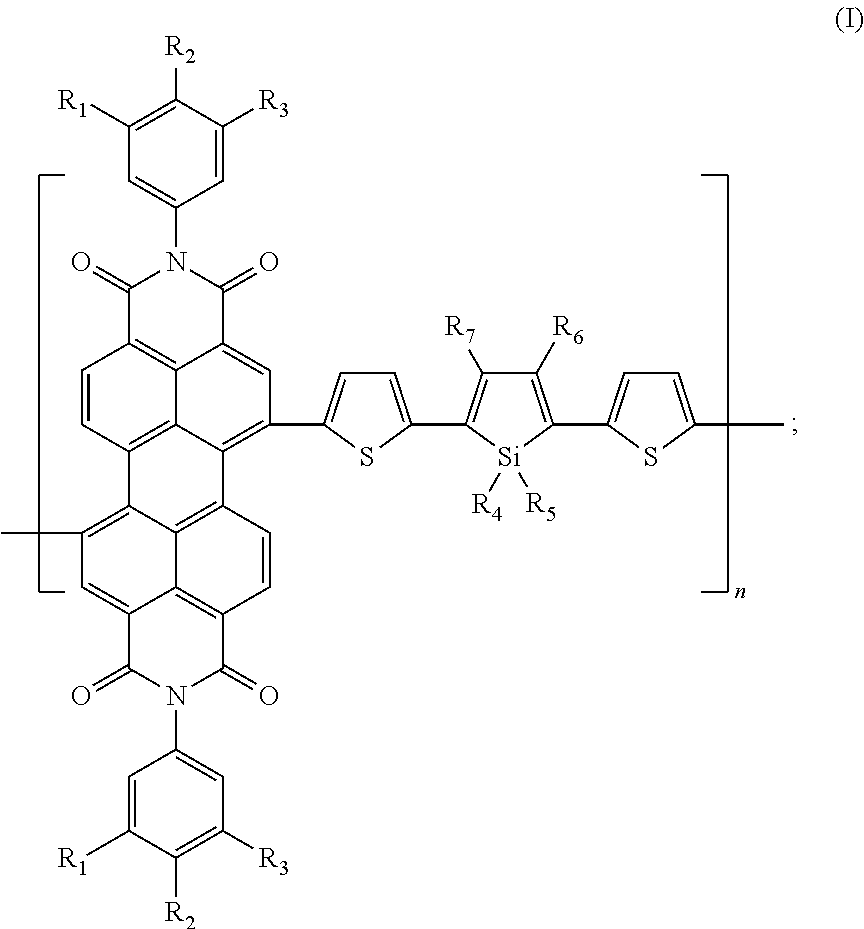Perylenetetracarboxylic diimide organic semiconductor material and the preparation method and application thereof
a technology of organic semiconductor materials and perylenetetracarboxylic diimide, which is applied in the field of organic semiconductor materials, can solve the problems of limited application, complicated production process and high cost, and the use of cheap materials in the photovoltaic field for the preparation of solar cells with low cost and high efficiency, so as to reduce the bandwidth of polymers, prolong the conjugate properties of polymers, and improve the solubility
- Summary
- Abstract
- Description
- Claims
- Application Information
AI Technical Summary
Benefits of technology
Problems solved by technology
Method used
Image
Examples
example 1
Preparation of poly(N,N′-di-(3,4,5-tri-methylbenzene)-3,4,9,10-perylene diimide-1,1,3,4-tetramethyl-2,5-bis-thienyl silole) (n=8)
[0028]
[0029]Under the protection of nitrogen, bubbling nitrogen into a DMF solution (18 mL) containing 0.5 mmol N,N′-di-(3,4,5-tri-methylbenzene)-1,7-dibromo-3,4,9,10-perylene diimide and 0.5 mmol 1,1,3,4-tetramethyl-2,5-bis(5-tributyltin-thienyl)silole for 0.5 h to remove the residual oxygen. Then adding 0.015 mmol Pd2(dba)3 and 0.030 mmol P(o-Tol)3, continuing to bubble nitrogen for 0.5 h to remove the residual oxygen; and then heating the solution to 80° C. to react for 48 h to obtain the reactant mixture solution containing poly(N,N′-di-(3,4,5-tri-methylbenzene)-3,4,9,10-perylene diimide-1,1,3,4-tetramethyl-2,5-bis-thienyl silole) (n=8).
[0030]Adding the mixture solution into methanol for sedimentation, suction-filtering, washing with methanol, and drying, then dissolving with toluene, and adding into an aqueous solution of sodium diethyldithiocarbamate...
example 2
Poly(N,N′-di-(3,5-dimethylalkoxy-4-dodecyloxy benzene)-3,4,9,10-perylene diimide-1,1-dioctyl-3,4-diphenyl-2,5-bis-thienyl silole) (n=25)
[0031]
[0032]Under the protection of nitrogen, bubbling nitrogen into a dioxane solution (15 mL) containing 0.5 mmol N,N′-di-(3,5-dimethylalkoxy-4-dodecyloxy)-1,7-dibromo-3,4,9,10-perylene diimide-1,1-dioctyl-3,4-diphenyl-2,5-bis(5-tributyltin-thienyl)silole for 0.5 h to remove the residual oxygen. Then adding 10 mg Pd(PPh3)2Cl2, continuing to bubble nitrogen for 0.5 h to remove the residual oxygen; then heating the solution to 85° C. to react for 36 h to , obtain the reactant mixture solution containing poly(N,N′-di-(3,5-dimethylalkoxy-4-dodecyloxy benzene)-3,4,9,10-perylene diimide-1,1-dioctyl-3,4-diphenyl-2,5-bis-thienyl silole) (n=25).
[0033]Adding the mixture solution into methanol for sedimentation, suction-filtering, washing with methanol, and drying, then dissolving with toluene, and adding into an aqueous solution of sodium diethyldithiocarba...
example 3
Poly(N,N′-di-(3,4,5-tri-eicosyl benzene)-3,4,9,10-perylene diimide-1,1,3,4-tetra-eicosyl-2,5-bis-thienyl silole) (n=100)
[0034]
[0035]Under the protection of nitrogen, bubbling nitrogen into a toluene / THF solution (30 mL) containing 0.5 mmol N,N′-di-(3,4,5-tri-eicosyl benzene)-1,7-dibromo-3,4,9,10-perylene diimide and 0.5 mmol 1,1,3,4-tetra-eicosyl-2,5-bis(5-tributyltin-thienyl)silole for 0.5 h to remove the residual oxygen. Then adding 8 mg Pd(PPh3)4, continuing to bubble nitrogen for 0.5 h to remove the residual oxygen; then heating the solution to 80° C. to react for 72 h to obtain the reactant mixture solution containing poly(N,N′-di-(3,4,5-tri-eicosyl benzene)-3,4,9,10-perylene diimide-1,1,3,4-tetra-eicosyl-2,5-bis-thienyl silole) (n=100).
[0036]Adding the mixture solution into methanol for sedimentation, suction-filtering, washing with methanol, and drying, then dissolving with toluene, and adding into an aqueous solution of sodium diethyldithiocarbamate; then heating the mixture...
PUM
| Property | Measurement | Unit |
|---|---|---|
| temperature | aaaaa | aaaaa |
| molar ratio | aaaaa | aaaaa |
| thickness | aaaaa | aaaaa |
Abstract
Description
Claims
Application Information
 Login to View More
Login to View More - R&D
- Intellectual Property
- Life Sciences
- Materials
- Tech Scout
- Unparalleled Data Quality
- Higher Quality Content
- 60% Fewer Hallucinations
Browse by: Latest US Patents, China's latest patents, Technical Efficacy Thesaurus, Application Domain, Technology Topic, Popular Technical Reports.
© 2025 PatSnap. All rights reserved.Legal|Privacy policy|Modern Slavery Act Transparency Statement|Sitemap|About US| Contact US: help@patsnap.com



